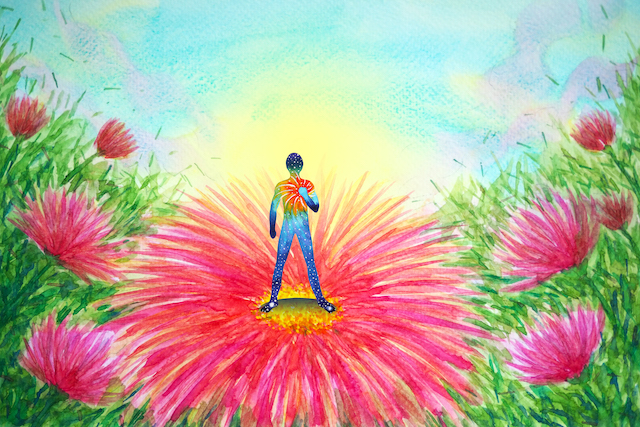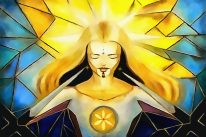
“In order to move on, you must understand why you felt what you did and why you no longer need to feel it.” ~Mitch Albom
The marble tile felt cold and hard against the side of my body as I lay sobbing and shaking on the floor. Some part of my mind nudged me to get to the couch, but I couldn’t. What did it matter?
Tears kept flowing as my moans of “Why? Why? Why?” echoed through the room. Despite the discomfort, I curled into a tighter fetal position on the floor, continuing to sob and whimper. Every once in a while, I would cough and gag, a familiar side effect of crying so hard.
After ten minutes, I had the clarity and energy to get up. I wiped my tears, blew my nose, and took several deep breaths, each one shaky and ragged.
This moment mirrored dozens of other similar moments over the past two years. The severity had lessened, perhaps due to therapy or simply the passing of time. However, I never knew the deep sorrow would hit again and bring me down, literally.
Most people experience this type of loss at some point. Mine resulted from a dearly loved and close family member telling me they never wanted to talk to me again and wanted me out of their life, in words much harsher and more hurtful.
Deeply rooted feelings of insecurity from a childhood filled with physical and emotional abuse rose to the surface (that’s a story for another time), compounding my feelings of wretchedness, unworthiness, and loss.
As I mentioned above, time and an incredible estrangement therapist had begun to heal some of the pain. I gravitated to therapy because I have my master’s and part of my PhD in Psychology. My clients found relief and recovery with me through cognitive behavioral, narrative, and art therapy methods. I did feel better talking with my skilled and experienced therapist.
However, I continually felt unstable. Imagine having to walk on a balance beam all the time. You get used to it and feel more competent, but you never have the same stability as walking on solid ground. I knew I had to get my emotions on firm footing.
I had used Traditional Chinese Medicine (TCM) as my primary healthcare model for eight years. I know the acupuncture and herbs eased some of the extreme sadness. However, after this bout of waterworks and wailing, I realized I needed to learn more about what TCM says about the emotions. So I began to research, and my life changed forever.
According to TCM, imbalanced emotions cause disease and mental health problems. Each organ relates to a pair of emotions, and when they are healthy you let go of the imbalanced emotions and retain a balanced state.
- Lungs: Imbalanced = loss, grief, and sorrow; Balanced = dignity, integrity, and courage
- Kidneys: Imbalanced = fear, loneliness; Balanced = self-confidence and inner strength
- Liver: Imbalanced = anger, frustration, impatience; Balanced = kindness and compassion
- Heart: Imbalanced = nervousness, excessive joy, and anxiety; Balanced = joy, contentment, and tranquility
- Spleen: Imbalanced = overthinking, obsessiveness, and worry; Balanced = trust and openness
I felt a significant shift in how I viewed emotions. Clarity arose about how my state of mind harmed or healed my body and vice versa.
The good news from my research was that people can skillfully balance their feelings.
One of the most powerful tools to do so is qigong.
Two Chinese characters comprise qigong: qi 气and gong 功. You can roughly translate qi to mean energy or life force. It’s more complicated than that, but that imagery works for this discussion. Gong means work or skill. Therefore, qigong means developing skill in working with energy.
Qigong originated from primitive people’s efforts to nurture their health. In fact, in 1957, when archaeologists excavated graves from over 5,000 years ago, they found a colored ceramic basin painted with a figure doing various qigong movements.
Qigong in ancient China was also called tuna (adjustment of breathing), daoyin (moving the body and breathing), zuochan (sitting in meditation), or neigong (internal exercise). These translations emphasize the importance of breathing and using the mind when doing qigong exercises.
A nice description of qigong for today is the skill of physical and mental training that weaves together the functions of the body, breathing, and the mind. When you integrate these three elements, you adjust the yin and yang balance in your body to prevent and reverse physical and mental disease.
The key to remember is that, just as with any other skill, you need to practice.
Living in Shanghai, China at the time of my exploration, I joined qigong classes at the parks near my home. At the time I wasn’t immersed in the theory, just the movements. This level of practice brought a sense of relief. I didn’t feel on the verge of falling off the balance beam at any given moment.
Nevertheless, the shaky foundation persisted. So, I dove deeper into medical qigong theory and completed my qigong teacher certification to broaden my insights. During these studies, the healing power of sounds, colors, finger mudras, and walking patterns emerged as tools for balancing the emotions.
For example, as you read above, my sorrow and sadness related to my lungs. The lungs tie to the metal element, the season of fall, the color white, and the emotional healing sound “ssss.” The annual respiratory illnesses each autumn, the anniversary of the estrangement, finally made sense.
Another medical qigong concept I found affirmed that the initial willingness to cry served a purpose.
To illustrate, my study of qigong taught me that feeling and expressing emotions helps clear stagnant energy so the body can rebalance. For instance, there is an expression of long-term physical ailments being caused by “unshed tears.” Puffiness under the eyes is one symptom of this sub-health condition. Crying as needed serves as an important role in healing, and I had definitely done plenty of crying.
Having said that, lingering in this state slows recovery. Qigong exercises help focus the mind and release the imbalanced aspects of emotions from the body. Through qigong, the stagnant energy returns to the earth for recycling, and you live in a balanced state.
Perhaps the most efficacious tool for qigong practice is nature.
Qigong practitioners learn how to gather qi from plants, water, soil, sand, canyons, mountains, oceans, rivers, etc., as well as how to use this qi for regeneration and repair. You might have seen the plethora of new “forest bathing” books in bookstores. This healing modality stems from the same ancient roots as qigong and demonstrates the effectiveness of nature to heal.
You focus on the present moment, fully immersed in the sensations surrounding you and your breath.
As I’ve practiced and applied the curative tools of qigong, my literal and figurate feet are planted on the ground. Instead of balancing precariously on a thin beam of wood, I experience the ebbs and flows of life like a tree. My roots run deep into the earth creating a solid foundation, and my trunk serves as a stable core. From this position of solidity, my branches and leaves blow with the wind, experiencing the world. The tree remains stable and strong yet lives and enjoys life.
Whether extreme happiness (the birth of my grandson) or broken heartedness (my continued estrangement) come my way, I use the tools and mindset of qigong to rebalance. I learn the lessons each emotion teaches me and come back to center, rooted in nature and the present moment.
I no longer crumple to the floor. Now, when the subtle energy shifts that occur when thinking of my estrangement surface, they nudge me instead of assailing me.
The greatest gift from this experience is the opportunity to teach others about qigong for emotional healing.
Your body wants to partner with you to heal and balance your emotions. Whether with me or other skilled qigong practitioners, you now have another tool to add to your toolbox of emotional well-being.
About Dr. Juli Kramer
Dr. Juli Kramer is a certified qigong, meditation, and TCM beauty secrets instructor. She holds a diploma in Chinese Medicine Nutritional Therapy and multiple certificates in Chinese medicine and face reading. Juli also has a Ph.D. in Curriculum and Counseling Psychology. Through Radiant Shenti, Juli and other teachers offer instruction live and through a private video library, incorporating nutrition, gua sha, meditation, yoga, reiki, Shamanic healing, and more in their lessons. Juli also teaches for AARP and Insight Timer.













 Though I run this site, it is not mine. It's ours. It's not about me. It's about us. Your stories and your wisdom are just as meaningful as mine.
Though I run this site, it is not mine. It's ours. It's not about me. It's about us. Your stories and your wisdom are just as meaningful as mine. 